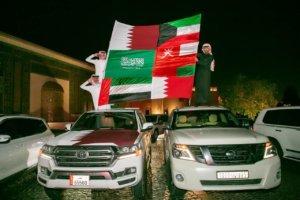Our Differences Bring Us Closer Together
December is Languages and Diversity month here at QAIC. In honor of this month’s theme, QAIC fellow Abdelrahman Kamel explored how sports can influence our beliefs on identity and nationalism. Abdelrahman studies at Queen’s University in Canada, where he is pursuing a Ph.D. in Cultural Studies.
After watching the opening of the FIFA Arab cup in Qatar, I found myself reflecting on a particular segment, which was the performance of the national anthems of all participating countries. This performance was conducted by three very talented singers and picked specific lines or verses from different national anthems that correspond with one another. For a moment, it felt like all these anthems are not so different from one another (after all they were mostly in Arabic).
Moreover, the performance’s poetic energy captures not just an expression of individual sentiments of nationalism, but also a shared regional culture. The FIFA Arab cup performance represents an oxymoron where national anthems are both an expression of state nationalism and a transnational unified culture.
The core value of a national anthem is to be a representation of nationalism, as it symbolizes how a group of people are a part of a particular ‘us;’ a distinct geographic, cultural, and social association that one considers as his or her own. This is to show that there is a distinct relationship between place and identity, yet the definition of nationalism is constantly contested in our increasingly globalizing contemporary time. To better understand this struggle, we have to reflect on the deeper understanding of place and its relationship with nationalism. An example of a conversation that explains the relationship between identity and space is one from the literary classic “Ulysses,” where a Jewish Irish character named ‘Bloom’, was asked about the definition of a ‘nation,’ and his answer was: “A nation is the same people living in the same place” (Joyce 331). Realizing how vague his answer was, he adds: “Or also living in different places” (Joyce 331). Reflecting on this further, we realize that we do not have a better definition of what establishes a nation or how a relationship with a specific place is formulated. In other words, local and diasporic populations both express sentiments of nationalism and attachment to homelands that they have never set foot in. Nevertheless, nationalism as a practice activated by the state or individuals remains a central part of modern cosmopolitan Identity. However, in the context of the FIFA Arab Cup, there were moments where sentiments of a shared Arab identity overcame notions of nationalism. Perhaps this is best symbolized by the Algerian team carrying the Palestinian flag alongside their own after their victory in the championship’s final match.

Figure 1: The Algerian team raising the Palestinian flag moments after winning the FIFA Arab Cup championship.
Or the countless pictures of crowds carrying the flags of nations other than their own as a symbol of unity.
In a way one can say that nationalism takes on a different meaning in the Arab context, one where differences don’t separate us, instead they bring us closer together. This notion of Arab ness is best exemplified by Mahmoud Mohamed Shaker’s Interview on Arab and Arabness, as he states, “I am only an Arab, not an Egyptian, or a Levantine, an Iraqi, Moroccan, Tunisian nor Sudanese. I am from all these nations, the son of all these nations” (Shaker).

Figure 2: Arab Cup celebrations in Katara, Doha, Qatar.
Work Cited
Joyce, James A. Ulysses. 1992 Modern Library Edition ed. New York: The Modern Library, 1934. 331. Print.
Shaker, Mohamed. لقاء الأستاذ محمود شاكر مع إذاعة الكويت. 1971, www.youtube.com/watch?v=VA71ePrxLo8.

